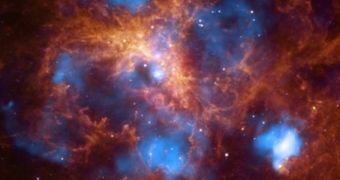During a new scientific study of the Tarantula Nebula, astronomers using the NASA Spitzer Space Telescope were able to discover vast volumes of radiations and powerful stellar winds inside the cosmic structure.
The findings again indicate that the stellar nursery is extremely active, producing young stars at a frantic pace. Gas clouds in the nebula were found to be heated to millions of degrees. Solar winds from about 2,400 blue stars were found to be responsible for this.
Additional data from the NASA Chandra X-ray Observatory reveals sonic booms caused by stars and supernova events, which carve out massive hollows inside 30 Doradus. These information were combined with those obtained by Spitzer, in order to produce the new image.
The Tarantula Nebula is located in the Large Magellanic Cloud, a dwarf galaxy that orbits the Milky Way. It is widely considered to be one of the most beautiful cosmic nebulae, especially in infrared and X-ray wavelengths.

 14 DAY TRIAL //
14 DAY TRIAL //